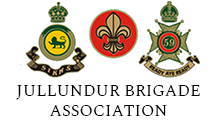The 59th (now 1st) scinde frontier force regiment
Having its ancestry in the famous body of troops originally formed for policing in the Punjab, the ‘frontier brigade’ was raised in 1846 for service in the Trans and Cis – Suliej states, the first tour regiments being styled as “Sikh Infantry”. The men were recruited largely from the disbanded contingents raised in the Phulkian States and the Malwa region. Similarly, the Frontier Force Rifle’s were, in their origin, Punjab Infantry units of the Trans - Frontier Brigade, created by Lord Dalhousie in 1849, first recruits being largely found from ‘demobilised’ soldiers of the Sikh Durbar.
The “Irregular Force” was almost permanently stationed in the Frontier Districts, arduous and wearing duty in the turbulent barren rocky hills and sandy stretches, defending isolated outposts against a merciless foe.
General Sir Charles Napier’s famous Camel Corps was raised for service on the Scinde frontier in order to check the frequent the cultivate lands of Scinde proper from the hills. Napier had decided sometime in July 1842 that his problem of keeping order amongst the wild desert robber-tribes could best be solved by a Camel Corps on the lines of Napoleon’s Dromedary Corps in Egypt. Actually, raised in December 1843 by Lieutenants Robert FitzGerald and George Green, the Corps was ready by January 1844 and Sir Charles Napier entered in his journal “I am Ready Aye Ready”, a motto which remains with the Battalion to this day and which was embodied in their crest by permission of Her Majesty Queen Victoria.
The Scinde Camel Corps was composed of 4 British officers and 5- 600 soldiers with a similar number of trained riding camels, each with a driver - attendant. Being a formation for specialist tasks in war but expensive to maintain in peace, the Camel Corps were re-organised into a light infantry battalion ten years later. The soldiers were armed with rifles (Brunswick models, with two-grove rifling and firing a special projectile, not very reliable) and the administration transferred from the Bombay Presidency to the Punjab Government, the unit becoming the 6th Regiment of the Irregular Force, (formerly Frontier Brigade) and styled as ‘The Scinde Rifle Corps”. The ‘Irregular Force” became the “Frontier Force” in 1865 but four decades later the Force as such was re-named in 1903, the titles of the Punjab Infantry battalions becoming “Rifles”, a compliment for their services. The 6th Punjab Infantry thus became the 59th Scinde Rifles (Frontier Force).
Until 1857 the Force remained engaged in ‘frontier work’, involving numerous armed expeditions into tribal territory arid engaged against marauding tribesmen from the North-West. The “Irregular Force” were engaged in subduing mutinous troops in Oudh, Rohilkhand and the Terai areas. The 55th Coke’s Rifles, 56 Punjabi Rifles and 57th Wildes Rifles marched a thousand miles from the Frontier to Delhi under John Nicholson and, marching together with the Guides Cavalry, dispersed the rebels at Najafgarh. At the capture of Lucknow, the 57th stormed Sikandarabagh together with the Argyll and Sutherland Highlanders, Subedar Gokal Singh displaying conspicious gallantry. The 56th (then 2nd Punjab Infantry) took part in the storming of Kashmere Gate at Delhi and later the Relief of the Residency at Lucknow. It was at the latter that then Lieutenant Roberts RE. raised the Queen’s Colour of the 56th on the Mess Tower in spite of fierce fire. Awarded the Victoria Cross, he finally went on many years later to become the legendary Field Marshal Lord Roberts of Kandahar.
Fierce fighting on the Frontier occurred during the Ambeyla campaign of 1863 and the 59th Scinde Rifles made a conspicuously gallant charge during the attack on the ‘Eagles Nest Piquat”. The 59th continued its watch and ward duties on the Frontier but all the other battalions were involved in the various columns and phases of the 2nd Afghan War. The 55th were in the Kandahar column, the 56th and 58th advanced to Kabul via the Kurram, while the 57th went to the Khyber line. All the five battalions, however, took part in the Miranzai valley expeditions in 1891, seeing some severe fighting before the rebellious clan could be subdued.
The 56th, 57th and 59th took part in the Waziristan operations during 1894-95, earning innumerable campaign clasps, some warriors in the Frontier Force possessing up to ten. In 1897, at Maizar in the Tochi Valley, a party of the 55th escorting their political officer, were treacherously attacked and the heroic devotion and sacrifice of Subedar Sundar Singh and a dozen men in defending the party, was one of the feats in an incident of bravery, training and discipline “which no military corps in the world could surpass”.
While the 57th and 59th were holding the Mahsuds, the 55th, 56th and 58th participated in what became the greatest campaign of the Northwest Frontier. A couple of years later, the 57th went to China, seeing service at Eu-sing during the Boxer troubles of 1900-01.
The 57th, 58th and 59th were part of the Indian Corps which went to war in France in October 1914.
The 59th Scinde Rifles (Frontier Force) are now the 1st Battalion (Scinde) of the Frontier Force Regiment of the Pakistan Army.
